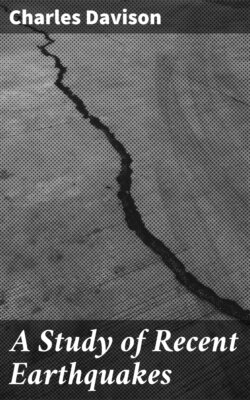Читать книгу A Study of Recent Earthquakes - Charles Davison - Страница 44
На сайте Литреса книга снята с продажи.
CHARACTERISTICS OF ISCHIAN EARTHQUAKES.
ОглавлениеAfter the eruption of 1302, there succeeded a period of comparative repose in Ischia. The revival of activity dates from 1762, and, since that year, there have been four great earthquakes, namely, those of 1796, 1828, 1881, and 1883. In every respect but that of increasing intensity, these earthquakes were apparently identical; each, as Professor Mercalli says, was merely a replica on a different scale of those that preceded it. The principal features in which they resemble one another, and differ from the average tectonic earthquake, are the coincidence of the epicentres, the small depth of the foci, and the sudden onset of the principal shock.
1. Coincidence of Epicentres.—In Fig. 14, which is copied from Professor Mercalli's map, are shown the areas in which buildings were seriously damaged by these four earthquakes. The curves for 1796, 1828, and 1881 are approximately concentric. In 1796, the shock was disastrous only to the west of Casamicciola; in 1828, according to Covelli, "the ground most injured was not precisely the region of Casamicciola, but that which lies between the district called Fango and that known as Casamenella, situated to the west of Casamicciola, and a short distance from it."[26] The epicentres may have varied slightly in size, but, in position, it is clear that all four were nearly or quite coincident. The meizoseismal bands in 1881 and 1883 were also similar in form and elongated in the same direction.
In the last two earthquakes there was, as we have seen, very distinct evidence of a secondary meizoseismal area surrounding Fontana, and it is remarkable that this was also noticeable in the earthquake of 1828. "Besides the centre of vibration in the district of Fango," says Covelli, "another less powerful centre showed itself in the locality of Fontana; this made itself felt more heavily than in surrounding localities; as if another centre of movement had taken place from that part, independent of the former."
2. Small Depth of the Foci.—Mallet's method, as noted above, cannot be trusted to yield accurate estimates of the focal depth, or to indicate more than its order of magnitude. But it is remarkable that the depths calculated by Dr. Johnston-Lavis for the last two earthquakes are both only a little less than a third of a mile, and it is probable that the actual depth did not differ very greatly from this amount. The nature of the shock, vertical or nearly so close to the epicentre and horizontal at a short distance from it, is merely personal testimony of the same character as fissures in masonry, and of course points to the same result.
Fig. 18.—Diagram showing connection between depth of focus and rate of decline in intensity.ToList
But the most conclusive evidence on which we have to rely is the extraordinary intensity of the shock at the centre of a very small distributed area. In Great Britain, an earthquake felt over a district of equal size would hardly at the centre exceed the trembling produced in a station platform by a passing train. The curves in Fig. 18 show how the rate of decline in intensity depends on the depth of the focus. They are drawn on the supposition that the intensity at any point on the surface varies inversely as the square of its distance from the focus; the curves a, b, c corresponding to foci situated at depths of one-third of a mile, one mile, and two miles respectively, and the figures below the horizontal line denoting the distance in miles from the epicentre. Thus, the rapid decline of intensity from the epicentre outwards shows that, in each of the four great Ischian earthquakes, the depths of the focus must have been very small.
3. Suddenness of the Shocks.—In 1796, we have no record of preparatory shocks, but the evidence is scanty; in 1828 and 1881, none are mentioned; in 1883, one or two tremors and underground noises, possibly of seismic origin, gave warning to a few. Fore-shocks, for all practical purposes, were conspicuous by their absence.
Still more remarkable is the sudden advent of the great shocks. There were no preliminary tremors or rumbling sound, no animals showed signs of uneasiness and no birds fluttered screaming from trees or ground. The shock of 1828, says Covelli, "was announced by three powerful blows coming almost vertically, from below upwards;" and the same words apply equally well to the earthquakes of 1881 and 1883. The destruction of houses in every case was practically instantaneous, and coincident with the first vibration.
In all respects, tectonic earthquakes differ widely from the Ischian shocks. The epicentres of successive earthquakes are rarely coincident, but show a distinct tendency to migration along certain lines; the decline in intensity outwards from the epicentre is nearly always very gradual, and therefore indicative of a comparatively deep-seated focus; they are almost invariably preceded either by a series of slight shocks and rumbling sounds, or, in an unstable district, by a marked increase in their frequency. Distinctions, so great as these are, evidently remove the Ischian shocks from the category of tectonic earthquakes.
